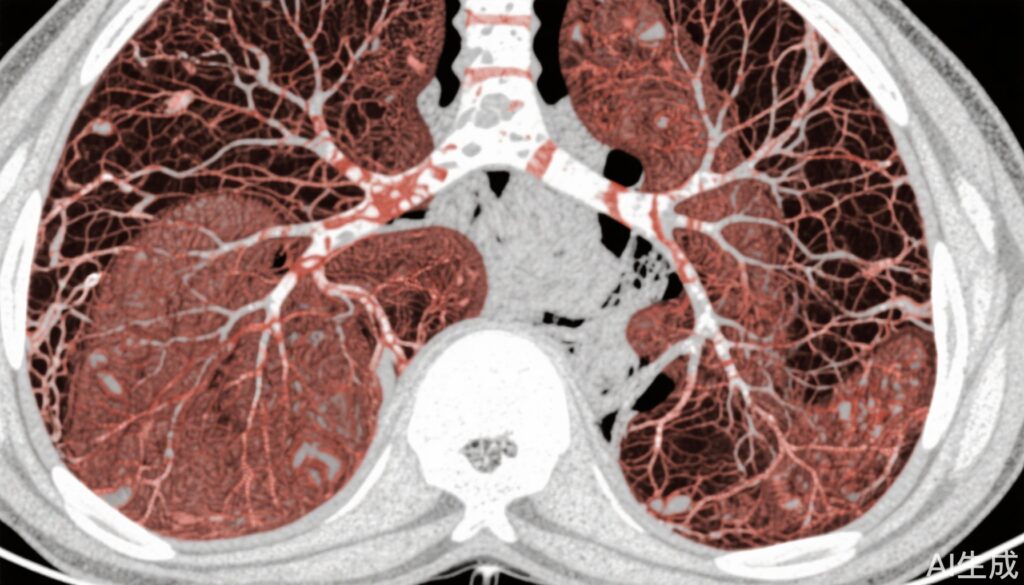Highlight
Nerandomilast, an oral preferential phosphodiesterase 4B inhibitor with antifibrotic and immunomodulatory properties, has demonstrated efficacy in reducing forced vital capacity (FVC) decline in patients with idiopathic pulmonary fibrosis (IPF) and progressive pulmonary fibrosis (PPF) over 52 weeks. Two large phase 3, randomized, double-blind, placebo-controlled trials (FIBRONEER-IPF and FIBRONEER-ILD) showed statistically significant and clinically relevant preservation of lung function compared to placebo. Diarrhea was the most common adverse event but was generally manageable.
Clinical Background and Disease Burden
Idiopathic pulmonary fibrosis (IPF) and progressive pulmonary fibrosis (PPF) represent devastating interstitial lung diseases characterized by relentless fibrotic remodeling of lung parenchyma leading to progressive respiratory failure. IPF is a chronic, progressive fibrosing interstitial pneumonia of unknown cause, predominantly affecting older adults. PPF encompasses a broader group of fibrotic lung diseases that show progression despite standard therapy. Both conditions carry high morbidity and mortality, with limited therapeutic options aimed at halting fibrotic progression. Current antifibrotic agents, such as nintedanib and pirfenidone, slow decline but additional treatments are needed to improve outcomes.
Research Methodology
Two phase 3, double-blind, randomized controlled trials were conducted to evaluate nerandomilast in IPF and PPF:
1. FIBRONEER-IPF Trial: 1177 patients with IPF were randomized 1:1:1 to nerandomilast 18 mg twice daily, 9 mg twice daily, or placebo. Stratification accounted for background antifibrotic therapy (nintedanib or pirfenidone vs. none). The primary endpoint was absolute change from baseline in forced vital capacity (FVC) in milliliters at 52 weeks.
2. FIBRONEER-ILD Trial: 1176 patients with PPF were randomized similarly to receive nerandomilast 18 mg, 9 mg twice daily, or placebo. Stratification included background nintedanib use and fibrotic pattern on high-resolution CT (usual interstitial pneumonia-like vs. other patterns). The primary endpoint was the absolute change in FVC at 52 weeks.
Both trials enrolled patients reflective of real-world populations, with substantial proportions on background antifibrotic therapy (77.7% in IPF, 43.5% in PPF). Safety and adverse events were systematically monitored.
Key Findings
In the FIBRONEER-IPF trial, the adjusted mean FVC decline at week 52 was −114.7 ml (95% CI, −141.8 to −87.5) for nerandomilast 18 mg, −138.6 ml (95% CI, −165.6 to −111.6) for 9 mg, and −183.5 ml (95% CI, −210.9 to −156.1) for placebo. Nerandomilast 18 mg resulted in a statistically significant difference of 68.8 ml (95% CI, 30.3 to 107.4; P<0.001) compared with placebo; 9 mg showed a difference of 44.9 ml (95% CI, 6.4 to 83.3; P=0.02).
In the FIBRONEER-ILD trial, the adjusted mean FVC decline at week 52 was −98.6 ml (95% CI, −123.7 to −73.4) for nerandomilast 18 mg, −84.6 ml (95% CI, −109.6 to −59.7) for 9 mg, and −165.8 ml (95% CI, −190.5 to −141.0) for placebo. Nerandomilast 18 mg and 9 mg both showed statistically significant differences compared to placebo of 67.2 ml (95% CI, 31.9 to 102.5; P<0.001) and 81.1 ml (95% CI, 46.0 to 116.3; P<0.001), respectively.
Diarrhea was the most common adverse event, occurring in 31.1–41.3% of nerandomilast groups versus 16.0–24.7% in placebo groups. Serious adverse events were comparable across all groups.
Mechanistic Insights and Biological Plausibility
Nerandomilast selectively inhibits phosphodiesterase 4B (PDE4B), an enzyme involved in degrading cyclic AMP, which modulates inflammatory and fibrotic pathways. By preferentially inhibiting PDE4B, nerandomilast exerts antifibrotic and immunomodulatory effects that may attenuate fibroblast activation and extracellular matrix deposition, thus slowing lung fibrosis progression. This mechanism complements the antifibrotic effects of existing therapies.
Expert Commentary
Experts highlight the significance of nerandomilast as a promising oral agent that adds to the therapeutic arsenal for fibrotic lung diseases. The trials incorporated patients on standard antifibrotics, demonstrating additive benefit and supporting use as combination therapy. The preservation of lung function, measured by FVC, is clinically meaningful, as FVC decline correlates with mortality risk.
Controversies and Limitations
Longer-term efficacy and safety beyond 52 weeks remain to be established. Diarrhea, while common, may affect adherence; strategies for management are necessary. The trials included a majority of patients on antifibrotics in IPF but fewer in PPF, which may influence generalizability. Moreover, subgroup analyses by fibrotic pattern and background therapy are important to guide personalized treatment but require further exploration.
Conclusion
Nerandomilast demonstrated robust efficacy in reducing lung function decline over 52 weeks in patients with IPF and PPF, with an acceptable safety profile. These findings represent a significant advance in fibrotic lung disease management, offering a novel therapeutic option that complements existing antifibrotics. Further studies should focus on long-term outcomes, quality of life, and optimal integration into clinical practice.
References
1. Richeldi L, et al. Nerandomilast in Patients with Idiopathic Pulmonary Fibrosis. N Engl J Med. 2025;392(22):2193-2202. doi:10.1056/NEJMoa2414108.
2. Maher TM, et al. Nerandomilast in Patients with Progressive Pulmonary Fibrosis. N Engl J Med. 2025;392(22):2203-2214. doi:10.1056/NEJMoa2503643.



